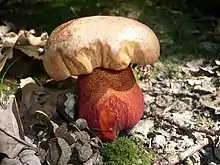Imperator luteocupreus
Imperator luteocupreus is a species of bolete fungus in the family Boletaceae. It is native to southern Europe, where it is found under chestnut (Castanea) and oak (Quercus).[1][2] Although it was originally described in genus Boletus, it was placed in the new genus Imperator in 2015, based on phylogenetic inferences.[3][4]
| Imperator luteocupreus | |
|---|---|
 | |
| Scientific classification | |
| Domain: | Eukaryota |
| Kingdom: | Fungi |
| Division: | Basidiomycota |
| Class: | Agaricomycetes |
| Order: | Boletales |
| Family: | Boletaceae |
| Genus: | Imperator |
| Species: | I. luteocupreus |
| Binomial name | |
| Imperator luteocupreus (Bertèa & Estadés) Assyov, Bellanger, Bertéa, Courtec., Koller, Loizides, G. Marques, J.A. Muñoz, N. Oppicelli, D. Puddu, F. Rich. & P.-A. Moreau (2015) | |
| Synonyms | |
|
Boletus luteocupreus Bertèa & Estadés | |
Mycologists Paul Bertéa and Alain Estadès described this species as Boletus luteocupreus in 1990. The type specimen had been collected by Estadès in 1986 from the Lachau commune in the Drôme department of southeastern France.[5] In a molecular analysis of Boletaceae phylogeny, Boletus luteocupreus was most closely related to B. torosus; these two species formed a clade that was sister to B. luridus.[6] Genetic analysis published in 2013 showed that B. luteocupreus and many (but not all) red-pored boletes were part of a dupainii clade (named for B. dupainii), well-removed from the core group of Boletus edulis (the type species of genus Boletus) and relatives within the Boletineae. This indicated that B. luteocupreus and its relatives needed to be placed in a new genus.[7] It was placed in the new genus Imperator, becoming Imperator luteocupreus, in 2015.[3]
The yellowish cap is up to 12 cm (4.7 in) in diameter and marked with orange spots. Hemispherical when young, it extends and flattens into a convex shape. The surface texture starts slightly velvety, becoming smoother with age. The pores on the cap underside are red, while the bulbous stipe yellow overlain with a prominent red net-like pattern, and measures up to 9 cm (3.5 in) high by 5 cm (2.0 in) thick. The flesh is thick and hard. It is yellow, except for the stipe base where it is deep red. It has an acidic taste. The smell is indistinct. All parts of the mushroom stain a deep blue when cut or bruised.[2]
It resembles Imperator torosus but can be distinguished by its red (rather than yellow) pores.[2]
Imperator luteocupreus occurs in the Canary Islands,[8] Menorca,[9] Cyprus,[4] Serbia,[10] North Macedonia,[11] Moldova,[12] Sicily,[13] Corsica, France, Germany, Italy, Spain, and Bulgaria, where it is rare. It may also be present in Greece and Switzerland.[2] It grows under oak (Quercus).[5] It grows under sweet chestnut (Castanea sativa) in Bulgaria.[2]
See also
References
- Binder M, Hibbett DS (2004). "Part 2: Figure 1C of the Proposed Research". Toward a Global Phylogeny of the Boletales. Worcester, Massachusetts: Clark University. Archived from the original on 25 September 2013. Retrieved 13 April 2013.
- Assyov, Boris (2005). "New and rare Bulgarian boletes". Mycologia Balcanica: 75–81.
- Assyov B, Bellanger JM, Bertéa P, Courtecuisse R, Koller G, Loizides M, Marques G, Muñoz JA, Oppicelli N, Puddu D, Richard F, Moreau PA (May 21, 2015). "Nomenclatural novelties". Index Fungorum (243).
- Loizides M, Bellanger JM, Assyov B, Moreau PA, Richard F (2019). "Present status and future of boletoid fungi (Boletaceae) on the island of Cyprus: cryptic and threatened diversity unraveled by 10-year study". Fungal Ecology. 41 (13): 65–81. doi:10.1016/j.funeco.2019.03.008. S2CID 181958289.
- Bertéa, Paul (1990). "Boletus luteocupreus sp. nov". Docums Mycologiques. 20 (78): 10.
- Halling RE, Baroni TJ, Binder M (2007). "A new genus of Boletaceae from eastern North America". Mycologia. 99 (2): 310–16. doi:10.3852/mycologia.99.2.310. PMID 17682784.
- Nuhn ME, Binder M, Taylor AFS, Halling RE, Hibbett DS (2013). "Phylogenetic overview of the Boletineae". Fungal Biology. 117 (7–8): 479–511. doi:10.1016/j.funbio.2013.04.008. PMID 23931115.
- Vicente J. Escobio García; Domingo Chávez Barreto; José Luis Lantigua Calderín; Jacobo Santiago Castillo; Yolanda Toledo Hernández; Rubén Naranjo Rodríguez; Luis Jiménez Barroso; Juan Francisco López-Quintanilla; Julio Daniel Rodrigo Pérez; José Ignacio Velaz Vergara (2016). "Últimas aportaciones al Orden Boletales en las Islas Canarias [Last appointments of the Order Boletales from the Canary Islands]". Cantarela (in Spanish) (71): 1–4. ISSN 1885-0154.
- J. LL. MELIS 1, G. MIR 2, M. C. PRATS 3 (2017). "Contribution to the mycological catalog of the Balearic Island. Menorca, II" (PDF). Micobotanica-Jaen. 7 (1).
{{cite journal}}: CS1 maint: multiple names: authors list (link) - Lukić, Nebojša (2009). "The distribution and diversity of Boletus genus in central Serbia" (PDF). Kragujevac J. Sci. 31: 59–68.
- Karadelev, Mitko; Rusevska, Katerina (2012). "Contribution to Macedonian red list of fungi" (PDF). Proceedings of the 4th Congress of Ecologists of Macedonia with International Participation Ohrid, 12–15 October 2012 Macedonian Ecological Society (28). Archived from the original (PDF) on 2021-04-18.
- Manic, Ştefan (2018). "THE FAMILY BOLETACEAE IN THE MYCOBIOTA OF THE REPUBLIC OF MOLDOVA" (PDF). Journal of Botany. 10 (2): 27–31.
- Venturella, Giuseppe; Saitta, Alessandro (2005). "The current state of knowledge of fungal diversity in Sicily" (PDF). Mycologia Balcanica. 2: 193–196.
External links
- Imperator luteocupreus in Index Fungorum
 Media related to Imperator luteocupreus at Wikimedia Commons
Media related to Imperator luteocupreus at Wikimedia Commons